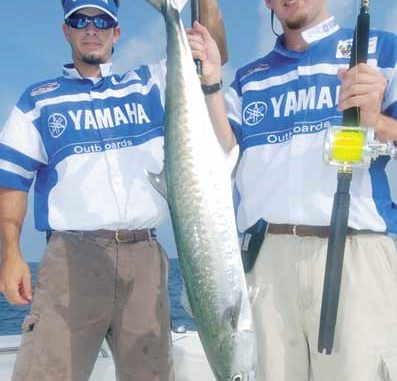
Sarah Jo’s dedicated fishing family jumps to Frying Pan Tower and finds fired-up king mackerel.
The southeastern coast of North Carolina is a producer of super-sized kingfish as well as superior king mackerel fishermen. The techniques anglers across the Atlantic and Gulf coasts take for granted in winning tournaments today originated right here. It’s no wonder local kids start fishing for outsized kings as soon as they have hands big enough to hold a live-bait rod and crank a revolving spool reel.
Christopher Edens Jr., 20, is the angler for Team Sarah Jo. Matt Markley is his best friend, head gaffer and cockpit manager, clearing the lines when a big kingfish smokes the bait. The team leader is Chris Edens Sr., a 48-year-old fishing veteran.
The younger members were born three days apart and have been friends and fishing buddies their entire lives. As kids, they coined their own personal vernacular, as children will, bestowing the term “mogan” to describe anything of beyond the normal, such as a tournament-winning kingfish.
“The king we caught to win the FLW Southport tournament last year month ago was just a mogan fish,” Christopher said. “It weighed 39 pounds, 5 ounces and put us in first place in the FLW North Carolina series at the time. We want to see if there’s another big king in the same place.”
Sarah Jo launched at Southport Marina one recent summer day, with the first stop at a tidal creek where the anglers regularly find menhaden. Slab-sided pogies were still there, resulting in two full live wells with a few casts of the nets.
With the bait situation handled, Chris headed for the Cape Fear River mouth, stopping to check the colored charts he had downloaded from the Internet.
“I’ve been computer fishing for a week,” Chris said. “I use Hilton’s Realtime-Navigator to check conditions. I’m trying to find conditions where the kings won’t be. When we head out to pre-fish a tournament, we’re trying to eliminate water. We also want to check spots where the fish have been, to verify whether they are still producing kings.”
Team Sarah Jo’s anglers don’t “fun” fish. They’re either fishing for practice or fishing a tournament. But while everything is serious business in the sense of trying to win, getting out on the water is always fun.
“The most fun for me has been seeing these boys grow up with fishing in their blood,” Chris said. “I know they’ll never get into any trouble. As involved in fishing as they are, they don’t have time for adverse distractions.”
The big kingfish Sarah Jo caught to win the previous FLW tournament at Southport came from a spot Chris christened “Hilton Hole” on his GPS unit in honor of the Hilton program. It was unusual because it had no bait, no structure or anything else conventional wisdom held that kings would be there. But all the information on the Hilton web site converged to send him to the spot.
“We caught the big king in 84.2-degree water,” Chris said. “We saw some bait on top that day and caught some on a Sabiki rig and used it to catch her.”
The closest Chris would come to describe the location of Hilton Hole is somewhere in the Frying Pan Shoals area. There’s a lot of live and hard bottom at the shoals, along with the out-of-service Frying Pan Shoal Light Station, otherwise known as Frying Pan Tower or just “the Tower.”
He was looking for several keys when he decided to drop his lines. The first was water temperature. The computer told him there was a 16-mile eddy of water 2.5 degrees cooler than surrounding water. It split into two eddies during the week, and he wanted to check them for kingfish.
Next was the water’s color. There’s a certain green color where ocean water edges toward cobalt blue, which Christopher named appropriately “king green.” A few of their kingfish came from the blue-water side. But the vast majority of Sarah Jo’s kings were caught from the king-green side.
Besides temperature and color, the anglers also checked currents with the web site because Chris said calm water with less turbulence holds bigger kingfish, which tend to be less energetic than small kings. He also wanted to find an upwelling through online information, which would indicate water with high fertility to attract baitfish. He said a downwelling is the kiss of death to king mackerel fishing.
Chris also said he had investigated the site for the right salinity and checked it off the list. But he was worried about a week-old chlorophyll reading. He said chlorophyll was the most difficult reading to get on a real-time basis but was probably the most important piece of information for finding big king mackerel.
Involved in chart reading, Chris accidentally bumped off a toggle switch, killing one live well. Making a note to tape the switch “on“ he reversed course to catch more menhaden. Sarah Jo passed through the river mouth just before 8 a.m., which disappointed Christopher because a major solunar feeding period would begin at 8:05 a.m.
“Sometimes Solunar feeding time predictions work; sometimes they don’t,” Chris said. “It’s just one more piece of information that might help you to catch a big king.”
The first fishing spot the anglers selected was east of the shoal. The water temperature read 83 degrees at the edge of the temperature break, and the crew spotted some baitfish on top. Twin 200 Yamaha HPDI outboards on the 2690 Triton boat had covered the calm sea miles in short order. Baits hit the water as quickly as the boat slowed to trolling idle. Two baits trailed behind down-rigger balls, one from a flat line and three rode shotgun from the T-top.
Team Sarah Jo uses Key Largo 12- to 20-pound class rods and Penn GS 545 reels spooled with 20-pound test mono, except for the longest shotgun line, which is set with an Avet LX 8 reel because of its fast retrieve gear ratio and 550 yards of line capacity.
The team fished several kinds of king mackerel tournament rigs, including one ribbonfish rig.
“A ribbonfish is shiny and it’s a big bait that will attract a big king,” Christopher said. “I rig it with a Hank Brown jighead in mirage color through the nose to hold the ribbonfish in place. Then I add No. 4 silver finish treble hooks about 6 or 7 inches apart along the length of the fish. I imbed the hooks along the dorsal fin (of the pogie) to hide them. The silver finish helps match the hooks to the shine of the ribbonfish so the kings won’t see them.”
The ribbonfish had been hand-caught, rather than coming from a shrimp net. The purpose was to minimize damage to the fish’s skin, which would have dulled its mirror-like reflective capability. The ribbonfish and one menhaden dropped on down-riggers. All the other lines trolled a live menhaden — or two or three.
“When you have small menhaden, or if you just want to create the illusion of lots of bait in the water, it pays to use a multiple menhaden rig,” Markley said. “We might use a No. 2 J-hook for the nose hook, but sometimes it’s a No. 4 treble. Sometimes we use treble hooks all the way and sometimes we might use J-hooks all the way. It depends on how the baits are swimming and how the king mackerel are reacting. The baits might swim differently with the treble than the J-hook.”
With multiple menhaden rigs, each baitfish is hooked through the nose. The hooks are spaced far enough apart that the menhaden aren’t touching. Combined with a ribbonfish to represent competition, the total area covered by a three dimensional trolling spread appears to be a natural school of baitfish swimming when scattered by a predator.
“A king hates a ribbonfish,” Christopher said. “To a king, it’s a competitor, and they’ll strike it savagely to eliminate it. Even if they don’t strike the ribbonfish, the ribbonfish makes kings act more aggressively toward the other baits.”
At the first fishing spot, two dogfish shark struck within 10 minutes. So the crew pulled the lines and Sarah Jo headed to another spot near Frying Pan Shoal.
The anglers offered the apparently finicky kingfish the additional enticement of Blue Water Candy skirts, dancing on the noses of menhaden baits in colors green, pink and chartreuse. The strategy worked, with a king striking the long shotgun line with a built-in head start of more than 100 yards.
The team, pre-fishing for an upcoming tournament, watched the horizon for other boats. Seeing another boat would have revealed their fishing spot, forcing Christopher, as the angler in the bow, to slink down from the bow fighting position to keep from advertising the location of the strike.
Chris maneuvered the boat to help his son gain line. Minutes later, Matt gaffed a 15-pound king. Getting the lines back quickly into the water resulted in another strike within 15 minutes. They released the 10-pounder, picked up lines and headed to another spot. Sarah Jo had a confirmed place holding fish for the tournament, so it was on to the next spot.
They checked water depth because all Sarah Jo’s recent catches had come at bottom depths of approximately 80 feet. The next fishing spot was within sight of Frying Pan Tower, and flying fish were fleeing from the boat, skittering across the surface. The water temperature was 82 degrees plus and the bottom dropped from 54 to 66 feet, with a secondary drop to 84 feet. The water was the perfect shade of king green, but the fish apparently hadn’t read the color chart because they wouldn’t strike.
A conversation over the VHF radio told the anglers that someone else was catching kings caught near the tower. Lines came up after half an hour’s trolling with no strikes despite the otherwise temptingly “fishy” conditions.
Moving to the shadow of the tower, the crew used Sabiki rigs to catch cigar minnows and sardines to use as bait. Fishing the fresh baits around the tower resulted in strikes from amberjack, barracuda, African pompano and a few “mystery fish” that could have been these same denizens of the deep or perhaps king mackerel, before they broke lines by wrapping them around the tower’s support structure.
Catching the bigger non-target fish burned off lots of line as well as fishing time. On the way back, another potential hot spot at one of the many wrecks in the area came through a tip from a competitor. Chris was networking with a couple of other competitors who shared reliable information. He said networking with dependable competitors who shared honest information among was vital to his success.
“This place is out of our normal fishing criteria with reference to the eight parameters of water chemistry and temperature we go by,” Chris said. “The water depth is too shallow compared to where we’ve caught fish. But the guy’s a reliable source so we’ll give it a try.”
The bottom was less than 80-feet deep, humping up into the 40-foot range from surrounding depths in the 50s and 60s. Before all lines were in the water, a fish struck a top line. But after the fish ran off a few yards of line, it jumped, leaving the crew to question whether it was a king. But the gamefish turned out to be a barracuda, which they quickly released.
Wind velocity increased, making sloppy sea conditions. The sun was tilting toward suppertime as the crew picked up lines for the last time to make the bumpy ride back home.
The anglers arrived at the Southport Marina dock at 6:38 p.m. Team Sarah Jo had fished eight fishing spots, finding at least one good place to fish an upcoming tournament.
“We did a good job of eliminating water today,” Christopher said. “We wanted to check off other places that might have tempted us to move away from a spot we knew was holding fish. It’s like the old saying about the grass being greener on the other side of the fence.
“Today, the rest of the ocean wasn’t any better at holding kings, even if it was king green.”

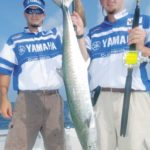
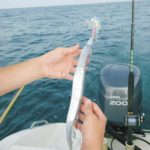
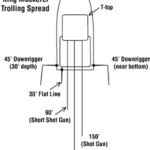
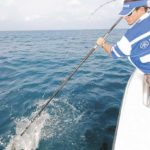
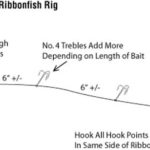
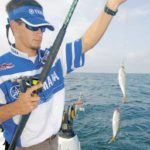
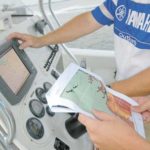
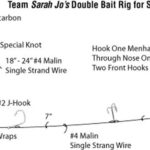
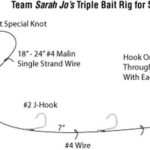
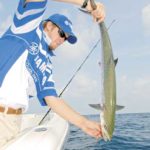
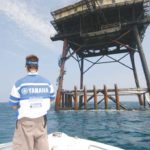
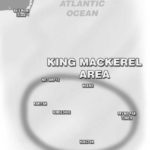



Be the first to comment